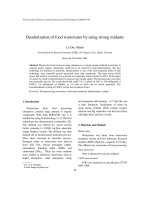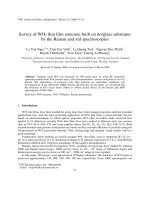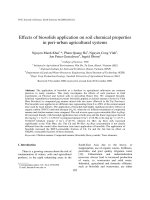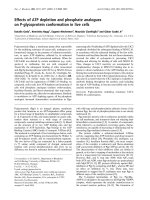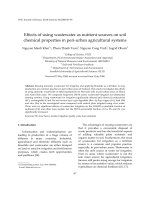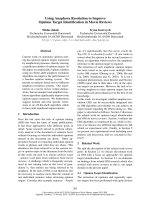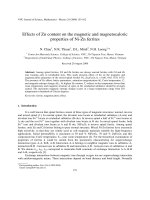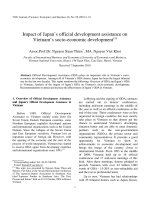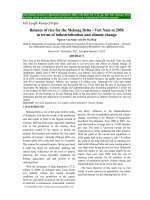Báo cáo " Effects of using wastewater as nutrient sources on soil chemical properties in peri‐urban agricultural systems " ppt
Bạn đang xem bản rút gọn của tài liệu. Xem và tải ngay bản đầy đủ của tài liệu tại đây (239.6 KB, 10 trang )
VNUJournalofScience,EarthSciences24(2008)87‐95
87
Effectsofusingwastewaterasnutrientsourcesonsoil
chemicalpropertiesinperi‐urbanagriculturalsystems
NguyenManhKhai
1,
*,PhamThanhTuan
2
,NguyenCongVinh
3
,IngridOborn
4
1
CollegeofScience,VNU
2
DepartmentofEnvironmentalImpactAssessmentandAppraisal,
MinistryofNaturalResourcesandEnvironment(MONRE)
3
SoilsandFertilizersInstitute
4
DepartmentofSoilSciencesandEnvironment,
SwedishUniversityofAgriculturalSciences(SLU)
Received27May2008;receivedinrevisedform5July2008
Abstract.Reusingdomesticwastewaterfor irrigationandapplying biosolids asafertiliser incrop
productionarecommonpracticesinperi‐urbanareasofVietnam.Thisstudyinvestigatestheeffects
ofusingdomestic wastewater infield experiments on Fluvisols soilsin peri‐urban areas of Hanoi
and Nam Dinh cities. We compared long‐term (30‐50 years) wastewater‐irrigated rice‐dominated
farming systems. Using wastewater for irrigation significantly affected pH,
electrical conductivity
(EC),exchangeableKandNaandreverseaquaregia‐digestible(RevAqReg)copper(Cu),lead(Pb)
and zinc (Zn) in the investigated areas compared with control plots irrigated using river water.
There were no significant effects of wastewater irrigation on the NH
4
NO
3
‐extractable fraction of
cadmium (Cd) and other trace metals, but the EDTA‐extractable fraction of Cu, Pb and Zn was
significantlyincreased.
Keywords:SEAsia;heavymetals;irrigation;paddysoils;traceelements
1.Introduction
*
Urbanisation and industrialisation are
leading to production of a huge volume of
effluents in many countries. Industrial,
agricultural and domestic effluents such as
biosolids and wastewater are either dumped
onlandorusedforirrigationandfertilisation
purposes, which creates both opportunities
andproblems[24].
_______
*Correspondingauthor.Tel.:84‐4‐5583306.
E‐mail:
Theadvantagesofreusingwastewaterare
that it provides a convenient disposal of
wasteproductsandhasthebeneficialaspects
of adding valuable plant nutrients and
organicmattertosoil.Furthermore,thereuse
of wastewater for irrigation as a fertiliser
source is a common and popular practice,
especially in peri‐urban
areas. Wastewater is
often the only source of water for irrigation.
Even in areas where wastewater is not the
sole water source for agricultural irrigation,
farmersstillpreferusingsewageforirrigation
byreasonofitsnutritivevalue,whichreduces
expenditureonchemicalfertilisers[10,17].
NguyenManhKhaietal./VNUJourn a lofScience,EarthSciences24(2008)87‐95
88
However, as wastes are products of
human society, enhanced concentrations of
potential toxic substances including trace
metals are generally found in wastewater,
which may limit the long‐term use of
effluentsfor agricultural purposes dueto the
likelihood of phytotoxicity, health and
environmental effects [1, 14]. Another
problem of wastewater disposal
on
agriculturallandisthepotentiallyphytotoxic
natureoforganicwastes,mainlyasaresultof
combinationoffactorssuchashighsalinityor
excessofammoniumions,organiccompounds
or low molecular weight fatty acids, which
e.g.mayinhibitseedgermination[6,10].
If the content of trace metals
increases
above a certain critical concentration due to
their accumulation in soil, this can have
negative environmental effects, which can
include negative effects on soil biota and
hence on microbial and faunal activity [7].
Furthermore, trace metals can affect crop
growth and quality, and thus pose risks for
humanhealth[2,
6,12].Therefore,therisk of
contamination by trace metals must be
considered when wastewater is applied and
understanding of the behaviour of metals in
the soil is essential for assessing
environmental risks of applying wastewater
inagro‐ecosystems.
The main objective of this paper was to
quantifythe effects
ofreuse of wastewateras
nutrient sources by: (i) investigating the
effects of long‐term wastewater irrigation on
soil pH, EC, organic carbon, total nitrogen
andtracemetals(cadmium(Cd),copper(Cu),
lead(Pb)andzinc (Zn)); (ii)investigatingthe
effects of application of wastewater,
especially as regards trace metal
accumulation
andsolubility.
2.Materialsandmethods
2.1.Locationoftheresearchareas
Soil samples were collected from peri‐
urban areas in two provinces of Vietnam,
including Hanoi, Nam Dinh (Table 1). The
sampled areas are located in delta and
lowland areas with a tropical monsoon
climate.The annualrainfallis
1500‐2000mm,
and more than 50% of the rainfall is
concentrated during June to August. The
meanmonthlytemperaturevariesbetween17
and29
o
C,withthewarmestperiodfromJune
to August and the coldest during December
andJanuary.
Table1.Descriptionofwastewater(full‐scalecasestudies)inexperimentsonFluvisolsin
peri‐urbanareasofHanoiandNamDinhcities,Vietnam
No. Location Soilirrigatedby Position Name Crop Application Samplingtime
1 Hanoi
Fluvisols Wastewater N:20°57.52ʹ
E:105°49.68ʹ
Treatment Rice Since1960s June2004
Riverwater N:20°58.12ʹ
E:105°48.15ʹ
Control Rice June2004
2 NamDinh
Fluvisols Wastewater N:20°44.93ʹ
E:106°20.98ʹ
Treatment Rice Since1980s June2004
Riverwater N:20°43.43ʹ
E:106°20.68ʹ
Control Rice June2004
NguyenManhKhaietal./VNUJourn a lofScience,EarthSciences24(2008)87‐95
89
2.2.Wastewaterirrigationinperi‐urbanagricultural
productionsystems
The sewage irrigation study areas are
located in urban regions downstream from
Hanoi City and Nam Dinh City. The soil
types are Eutric Fluvisol at the Hanoi site,
andHumi‐EndogleyicFluvisol(Eutric)atthe
Nam Dinh site according to the World
Reference Base for Soil Resources. The soils
are fertile and suitable for growing crops.
Rice has been the main crop in these areas,
butthere is atendency of changing from rice
to vegetable production due to increasing
demandfromtheinnercitymarketsofHanoi
and Nam Dinh. At
the Hanoi site, sewage
water has been used for irrigation since the
1960s. Because of water scarcity, agricultural
land has been irrigated by sewage from Kim
Nguu River, which runs through the urban
area to rural agricultural land [8, 9]. At the
Nam Dinh site, irrigation using wastewater
started in the
1980s as a result of increasing
urbanisation. The sewage mainly comprises
domestic water but also includes wastewater
and discharges from industrial activities in
theurbanareas[4,20].InNamDinh,thesoil
samples were taken in the fields where the
DANIDA‐IWMI project on wastewater reuse
inagriculturein
Vietnamwascarriedout[20].
2.3.Soilsamplingstr ate gyandsamplepreparation
Forassessmentoftheimpactofwast ewater,
soilsamplesweretakenfromthe topsoil(0‐20
cm) of all study sites in peri‐urban areas of
Hanoi(n=4)andNamDinh(n=8)usingasoil
auger. At every sampling
point, 3 to 5 sub‐
samples were taken from approximately 250
m
2
and mixed to obtaina bulk sample. Non‐
wastewater irrigated soils (ʺnaturalʺ river
irrigation)were also sampledforcomparison
(n=4forHanoi,andn=8forNamDinh).
Afterairdryingatroomtemperature,the
soil samples were ground and sieved to
remove particles > 2 mm, and then stored
in
plasticbags.Thesoilsampleswerebroughtto
Sweden(SLU)foranalysis.
2.4.Soilanalysis
Total N (N
tot
) and total organic carbon
(TOC) was determined on finely ground
samples on a LECO CHN analyser (Leco
CHN
®
CHN 932 analyser). Prior to the
analyses, the samples were treated by 4M
HCl (1:1 soil:solution ratio) for dissolution of
carbonates. The soil EC and pH were
measured in deionised H
2
O (1:5 soil:solution
ratio), and pH
CaCl2
was determined after
additionof0.5MCaCl
2
[18].The soil samples
were extracted with 1MNH
4
NO
3
for 2 hours
(1:2.5 soil:solution ratio) to quantify the
exchangeable and specifically adsorbed
fraction of trace metals (i.e. Cd, Cu, Pb, Zn)
[3]. Potentially bioavailable metals were
extracted with 0.025 M (Na)
2
EDTA (1:10
soil:solution ratio) for 1.5 h [19]. The reverse
aqua regia (3:1 HNO
3
:HCl ratio)‐digestible
fraction (Rev Aq Reg ) of Cd, Cu, Pb and Zn
was extracted using a method described by
Stevens et al. [18]. After centrifugation,
filtration and dilution (if necessary) metal
concentrations were determined by
inductivelycoupledplasma‐massspectrometry
(ICP‐MS,PerkinElmerELAN6100).
2.5.Watersampling
andwateranalysis
In Nam Dinh and Hanoi, water samples
were collected in summer 2004 from the Red
River and wastewater channels, which were
the irrigation sources at the study sites. The
pH and EC in these water samples were
determined directly after sampling.
Polyethylene bottles that had been pre‐
NguyenManhKhaietal./VNUJourn a lofScience,EarthSciences24(2008)87‐95
90
washed with acid and distilled water and
dried were used, and after sampling, a few
drops of concentrated HCl were added prior
tochemicalanalysis.
Water samples were analysed for their
totalconcentrationsof Ca, Cd,Cu,K,Mg, N,
P,PbandZn.Onealiquotofthesampleswas
digested
with boiling concentrated HNO
3
beforedeterminationofthetotalconcentration
of K by flame spectrometry; Ca, Mg and Na,
by atomic adsorption spectrophotometry
(AAS, Perkin Elmer 300); Cd, Cu, Pb and Zn
by ICP‐MS, and total P by HNO
3
digestion
followed by determination ofPO
4
‐P with the
ascorbic acid method [5]. Total N was
quantifiedasdescribedelsewhere[9].
2.6.Statisticalanalysis
Datafromtheexperimentswereanalysed
using the General Linear Model (GLM)
procedure of Minitab Software version 14.
Treatment means which showed significant
differences at the probability level of P<0.05
were compared
using Tukey´s pairwise
comparisonprocedure.Thesourceofirrigation
water within sites (wastewater and river
water)wasusedasa factorinthemodel.The
statistical model used was y
ij
=
µ
+
α
i
+ e
ij
,
where
µ
isthemeanvalueforalltreatment,
α
i
the different between mean value of
treatment i with overall mean, and e
ij
is the
randomerror.
3.Results
3.1.Irrigationwaterquality
Theresultsoftheirrigationwateranalysis
arepresentedinTable2.ThepHandECwere
significantlyhigherinthewastewater compared
withtheriverwater.Thewastewateralsohad
significantly higher concentrations of
nutrientsandtracemetalscompared
withthe
river water. This indicated that non‐treated
wastewater contained both nutrients that are
ofvalueforirrigation ofcropsinagricultural
systems,andpotentialtoxicelementsthatcan
affect soil production capacity and crop
quality. A comparison between wastewaters
in Hanoi and Nam Dinh showed that the
concentrations
in Hanoi wastewater were
significantly higher for most elements
includedinthestudy(i.e.Cd,Cu,K,Na,N
tot
,
P
tot
,Pb,Zn).
3.2.EffectsofapplyingwastewateronsoilpHand
electricalconductivity
Applying wastewater for irrigation
significantly increased soil pH (pH
H2O
and
pH
CaCl2
)atbothstudysites(HanoiandNam
Dinh) (Table 3), probably due to wastewater
being more alkaline than river water (Table
2). The similar effect was observed for
electrical conductivity, which was higher in
thewastewatertreatmentsthaninthecontrol
(river).
3.3.Effectsofapplyingwastewateronsoilorganic
carbonandtotalnitrogencontents
Reuseof wastewaterforirrigation caused
an increase in total organic carbon (TOC)
content and total nitrogen (N
tot
) in the soil at
both study sites (Fig. 1). The soils that had
received wastewater for irrigation had 1.68%
TOC and 0.19% N
tot
at the Hanoi site and
2.67% TOC and 0.26% N
tot
at the Nam Dinh
site. The corresponding values for control
samples were 1.29% (TOC), 0.15% (N
tot
) and
1.85%,(TOC),0.21%(N
tot
)forHanoiandNam
Dinh,respectively.
NguyenManhKhaietal./VNUJourn a lofScience,EarthSciences24(2008)87‐95
91
Table2.WaterqualityoftheRedRiverwaterandwastewaterusedforirrigationinHanoiandNamDinh.
Differentletters(a,b)denotesignificantdifferencesbetweensourcesofirrigationwaterwithinsites(P<0.05)
NamDinhHanoi
No Parameter Units
Red River
(n=4)
Wastewater
(n=5)
Red River
(n=4)
Wastewater
(n=6)
1 pH7.1
a
8.0
b
6.9
a
7.9
b
2 EC dSm
-1
0.20
a
0.82
b
0.21
a
0.86
b
3 Totalnitrogen(N
tot
) mgL
-1
4.1
a
10.8
b
3.9
a
19.2
b
4 Totalphosphorus(P
tot
) mgL
-1
0.6
a
2.0
b
0.5
a
4.4
b
5 Potassium(K) mgL
-1
3.1
a
6.8
b
4.1
a
12.8
b
6 Sodium(Na) mgL
-1
32.5
a
85.5
b
28.6
a
135.7
b
7 Calcium(Ca) mgL
-1
46.7
48.9
54.6
54.3
8 Magnesium(Mg) mgL
-1
12.5
10.1
14.2
12.4
9 Lead(Pb) µgL
-1
1
a
2
b
2
a
3
b
10 Zinc(Zn) µgL
-1
32
a
67
b
24
a
236
b
11 Copper(Cu) µgL
-1
14
a
42
b
18
a
82
b
12 Cadmium(Cd) µgL
-1
0.2
a
0.5
b
0.5
a
0.9
b
Table3.Electricconductivity(EC,µScm
-1
),pH,exchangeableCa,Mg,Na,K(1MNH
4
NO
3
extractable;gkg
-1
)
intopsoil(0‐20cm)samplesfromexperimentswithreuseofwastewater.Differentlettersdenotesignificant
differencesbetweentreatmentsatthesamesite(P<0.05)
Exchangeable
3
Site EC
1
pH
1
H2O
pH
2
CaCl2
K Na Ca Mg
Hanoi
Control 62.80
a
6.45
a
5.69
a
0.06
a
0.04
a
0.89 0.19
Wastewater 102.75
b
6.70
b
5.96
b
0.16
b
0.09
b
1.00 0.22
NamDinh
Control 78.25
a
5.99
a
5.42
a
0.06
a
0.04
a
1.55
0.18
Wastewater 179.38
b
6.36
b
5.71
b
0.12
b
0.17
b
1.60
0.21
1
pHinH
2
O,ratiosoil:water=1:5
2
pHin0.05MCaCl
2
,ratiosoil:solution=1:5
3
1MNH
4
NO
3
extractable,ratiosoil:solution=1:2.5
0.0
0.5
1.0
1.5
2.0
2.5
3.0
Hanoi Nam Dinh
Total organic carbon /
%
Control
Treatment
a
a
b
b
0.00
0.05
0.10
0.15
0.20
0.25
0.30
Hanoi Nam Dinh
Total nitrogen / %
a
a
b
b
Fig.1.Effectofwastewaterirrigationonsoilchemicalproperties,totalorganiccarbon(TOC,%),totalnitrogen
(N
tot
,%).Differentlettersdenotesignificantdifferencesbetweentreatmentandcontrolatthesamesite(P<0.05).
NguyenManhKhaietal./VNUJourn a lofScience,EarthSciences24(2008)87‐95
92
3.4.Effectsofapplyingwastewaterontracemetal
concentrationsinsoil
The concentrations of reverse aqua regia
(RevAqReg)‐digestibleCu,PbandZninsoils
receiving wastewater were significantly
higher than those in soils receiving river
water. There was no significant difference in
Cd concentration (Rev Aq Reg)
between
wastewater irrigated soils and control soils
(Fig. 3). The potentially bioavailable
concentrations of Cu, Pb and Zn (EDTA‐
extractable) in wastewater‐treated soils were
significantly higher than in control soils (no
difference for Cd). The NH
4
NO
3
‐extracted
fractions of Cd, Cu, Pb and Zn constituted
only a small proportion of the EDTA‐
extracted fractions. However, there was no
significant difference between treated soils
and control soils in the exchangeable
(NH
4
NO
3
) fraction of these metals (Table 4).
The reason of this might be low
concentrationsincombinationwithavariation
betweenthereplicates.
0
5
10
15
20
25
30
35
40
45
Hanoi Nam Dinh
Rev Aq Reg Cu / mg kg
-1
Control
Treatment
a
a
b
b
0
20
40
60
80
100
120
140
Hanoi Nam Dinh
Rev Aq Reg Zn / mg kg
-1
)
a
a
b
b
0.00
0.04
0.08
0.12
0.16
0.20
Hanoi Nam Dinh
Rev Aq Reg Cd / mg kg
-1
0
5
10
15
20
25
30
35
40
45
Hanoi Nam Dinh
Rev Aq Reg Pb / mg kg
-1
a
a
b
b
Fig.2.Effectofreuseofwastewateronreverseaquaregia(RevAqReg)‐extractableCd,Cu,PbandZn(mgkg
-1
)
concentrationsin soil.Differentlettersdenotesignificantdifferencesbetweentreatmen tandcontrolatthesam esite(P<0.05).
Table4.Effectofwastew a t er applicationon0.025MEDTA(mg kg
-1
dw)and1MNH
4
NO
3
extr a c ta b l e (mgkg
-1
dw)
tracemetals.Differentlettersdenotesignificantdifferencesbetweentr eatmentandcontrolatthesamesite(P<0.05)
EDTA‐extractableNH
4
NO
3
‐extractable
Site
Cu Zn Cd PbCu Zn Cd Pb
Hanoi
Control 8.21
a
1.85
a
0.112
a
7.18
a
0.002 0.150 0.0059 0.004
Treatment 9.53
b
2.97
b
0.105
a
8.89
b
0.004 0.205 0.0076 0.007
NamDinh
Control 10.99
a
1.63
a
0.120
b
11.10
a
0.009 0.120 0.0093 0.011
Treatment 12.65
b
1.75
b
0.126
b
15.32
b
0.006 0.180 0.0125 0.038
NguyenManhKhaietal./VNUJourn a lofScience,EarthSciences24(2008)87‐95
93
4.Discussion
Analyses of soil samples collected to
assesstheimpactsofsewageirrigationonthe
irrigatedagriculturalsoilsofperi‐urbanareas
of Hanoi and Nam Dinh cities showed that
reuse of municipal wastewater for irrigation
hadsignificantlyincreasedbothTOCandN
tot
in soils. This finding is in agreement with
previousstudieswherewastewaterirrigation
had been shown to increase soil organic C
and N [15]. However, a potential hazard to
peri‐urbancropproductionwasrevealeddue
to the accumulation of trace metals in
agriculturalsoilsirrigatedwithsewage.
Municipal wastewater
contains a variety
of inorganic substances from domestic and
industrial sources, including a number of
potentially toxic elements such as arsenic
(As), cadmium (Cd), chromium (Cr), copper
(Cu), mercury (Hg), lead (Pb), zinc (Zn), etc.
[16]. According to the annual report on the
environmental status of Vietnam made by
VEPA
[22], these potential toxic elements are
commonlypresentindomesticwastewaterof
manycitiesinVietnam.Evenifpotentialtoxic
elements in wastewater are not present in
concentrations likely to directly affect
humans and thus limit their agriculturaluse,
they seem to be higher than in natural river
water, which would
contaminate the
agriculturalsoilsinthelong‐term.Asaresult,
theconcentrationsoftracemetals(Cu,Pband
Zn) in the wastewater‐irrigated soils were
significantly higher than in control soils,
indicating that the application of wastewater
hadenrichedthesoilwithtracemetals.Liuet
al.(2005)studied
theimpactofsewageirrigation
on trace metal contamination in Beijing and
reported that the trace metals were enriched
inthesoilduetosewageirrigation [11].This
was also found in earlier publications about
effectsofsewageirrigationonsoils[13,21].
Theapplicationofwastewaterintheperi‐
urban sites of Hanoi and Nam Dinh cities
increased soil pH by approximately0.3 units
compared with the non‐wastewater irrigated
sites. Previous researches [8, 23] have
indicated that the wastewater applied for
irrigation at Hanoi and Nam Dinh sites is in
most cases neutral to alkaline (6.5 ‐8.5). The
present
study also found that the pH was
significantlyhigherforwastewatercompared
with natural river wa ter (Table 2). In
addition, the higher concentration of cations
such as Na and K in wastewater led to an
increaseinECandexchangeableNaandKin
soils irrigated with wastewater. The high
pH
of soils irrigated with wastewater might
reduce the mobility of the trace metals
accumulatedinthesesoils.
5.Conclusions
Reuse of wastewater as nutrient sources
has become common practice in Vietnam,
especially in peri‐urban areas. The reuse of
thesenutrientshadsomebeneficialeffectson
soil fertility, such as
increased total organic
carbon and nitrogen. This study found that
bothorganiccarboncontentandtotalnitrogen
were improved (increased) in soils treated
withwastewater.However,thesebenefitswere
limitedbythepresenceofsomepotentialtoxic
trace metals in wastewater. It was concluded
that the reuse of wastewater for
irrigation
increased soil pH, EC, TOC, N
tot
and total
concentration of Cu, Zn and Pb. The EDTA‐
extractable fraction of Cd, Cu and Zn was
significantly higher for wastewater‐irrigated
soils.
NguyenManhKhaietal./VNUJourn a lofScience,EarthSciences24(2008)87‐95
94
References
[1] B.J.Alloway,Theoriginofheavymetalsinsoils,
in Heavy metals in Soils, Chapman & Hall,
London,1995,38‐57.
[2] S.P. Datta, S.D. Young, Predicting metal uptake
and risk to the human food chain from leaf
vegetables grown on soils amended by long‐
termapplicationofsewage
sludge,WaterAirand
SoilPollution163(2005)119.
[3] B.E. Davies, J.M. Lear, N.J. Lewis, Plant
availabilityof heavymetal sin soils,in Pollutant
transport and fate in ecosystems, Blackwell
ScientificPublishers,Oxford,1987,267‐275.
[4] T.T. Duong, M. Coste, A. Feurtet‐Mazel, D.K.
Dang, C. Gold, Y.S.
Park, A.Boudou, Impact of
urbanpollution fromtheHanoi areaon benthic
diatom communities collected from the Red,
Nhueand Tolichrivers (Vietnam),Hydrobiologia
563(2006)201.
[5] A.D. Eaton, L.S. Clesceri, A.E. Greenberg,
Standard Methods for Examination of Water and
Wastewater, American Public Health Association,
Washington,1995,1‐124.
[6] B. ElHamouri, A. Handouf, M. Mekrane, M.
Touzani, A. Khana, K. Khallayoune, T.
Benchokroun, Use of wastewater for crop
production under arid and saline conditions:
Yield and hygienic quality of the crop and soil
contaminations, Water Science and Technology 33
(1996)327.
[7] K.E. Giller, E. Witter, S.P. McGrath,
Toxicity of
heavy metals to microorganisms and microbial
processes in agricultural soils: a review, Soil
BiologyandBiochemistry30(1998)1389.
[8] M.H.HoangFagerstrom,T.Yem,P.Q.Ha,V.D.
Tuan, C. Valhed, K. Kvamme, Y. Nyberg,
Characterization and diagnosis of rural‐urban
interfacefarming inthe TuLiemand Thanh
Tri
districts of Hanoi city, Vietnam, International
Journal of Sustainable Agriculture Sustainability 3
(2006)177.
[9] N.M. Khai,P.Q. Ha,I. Oborn,Nutrient flowsin
small‐scale peri‐urban vegetable farming
systems in Southeast Asia‐a case study in
Hanoi, Agriculture, Ecosystems & Environment
122(2007)192.
[10] V. Lazarova,
T. Asano, Challenges of
Sustainableirrigation withrecycledwater,inV.
Lazarova, A. Bahri, Water reuse for irrigation,
Agriculture, Landscapes and Turf Grass, CRC
Press,LondonNewYork,2005,1‐30.
[11] W.H.Liu,J.Z.Zhao,Z.Y.Ouyang,L.Soderlund,
G.H.Liu,Impactsofsewageirrigationonheavy
metaldistribution
andcontaminationinBeijing,
China,EnvironmentInternational31(2005)805.
[12] R.J. Mahler, J.A. Ryan, T. Reed, Cadmium
sulfate application to sludge‐amended soils I.
Effect on yield and cadmium availability to
plants, Science of the TotalEnvironment 67 (1987)
117.
[13] F.Mapanda,E.N.Mangwayana,J.Nyamangara,
K.E. Giller, The
effect of long‐term irrigation
using wastewater on heavy metal contents of
soils under vegetables in Harare, Zimbabwe,
Agriculture Ecosystems & Environment 107 (2005)
151.
[14] S.P. McGrath, Effects of heavy metals from
sewage sludge on soil microbes in agricultural
ecosystems, in S.M. Ross, Toxic metals in Soil‐
Plants systems,
John Wiley & Son, West Sussex,
1996,247‐274.
[15] G.T. Monnett, R.B. Reneau, C. Hagedorn,
Effectsof domesticwaste‐waterspray irrigation
on denitrification rates, Journal of Environmental
Quality24(1995)940.
[16] M. Muchuweti, J.W. Birkett, E. Chinyanga, R.
Zvauya, M.D. Scrimshaw, J.N. Lester, Heavy
metal content of
vegetables irrigated with
mixtures of wastewater and sewage sludge in
Zimbabwe: Implications for human health,
Agriculture,Ecosystems &Environment112(2006)41.
[17] M.B. Pescod, Wastewater treatment and use in
agriculture, Food and Agriculture Organization.
Rome,1992.
[18] D.Stevens,M.Smart,G.Cozens,B.Zarcinas,G.
Barry, T. Cockley,
M. McLaughlin, CSIRO Land
andWaterʹsMethodsManual,ACIARandCSIRO
LandandWater,2003.
[19] T. Streck, J. Richter, Heavy metal displacement
in a sandy soil at the field scale, 1,
Measurements and parameterization of
sorption, Journal of Environmental Quality 26
(1997)49.
NguyenManhKhaietal./VNUJourn a lofScience,EarthSciences24(2008)87‐95
95
[20] D.T. Trang, P.D. Cam, W. van der Hoek, K.T.
Vinh, N.V. Hoa, A. Dalsgaard, Low risk for
helminth infection in wastewater‐fed rice
cultivation in Vietnam, Journal of Water and
Health4(2006)321.
[21] X.J. Wang, Kriging and heavy metal pollution
assessment in wastewater irrigated agricultural
soil of Beijing
ʹs eastern farming regions, Journal
of Environmental Science and Health Part A 33
(1998)1057.
[22] VEPA,Vietnamenvironmentmonitor2003‐Water,
Vietnam Environment Protect Agency, Vietnam
MinistryofNaturalresourcesandEnvironment,
Hanoi,2004(inVietnamese).
[23] N.C. Vinh, N.D. Minh, Study on effect of
wastewater irrigation on soil
and rice in Nam
Dinh, In: Proceeding of scientific research of
National Institute for Soil and Fertilizer,
Agricultural Publish House, Hanoi, 2005, 567‐
580(inVietnamese).
[24] R.K. Yadav,B. Goyal, R.K. Sharma, S.K. Dubey,
P.S. Minhas, Post‐irrigation impact of domestic
sewage effluent on composition of soils, crops
and ground
water‐a case study, Environment
International28(2002)481.
